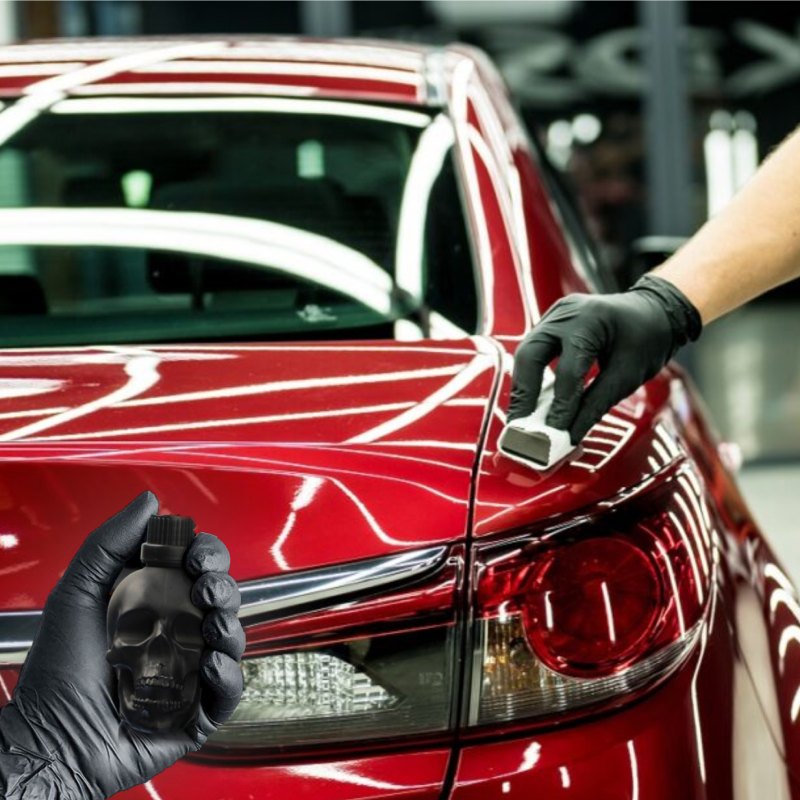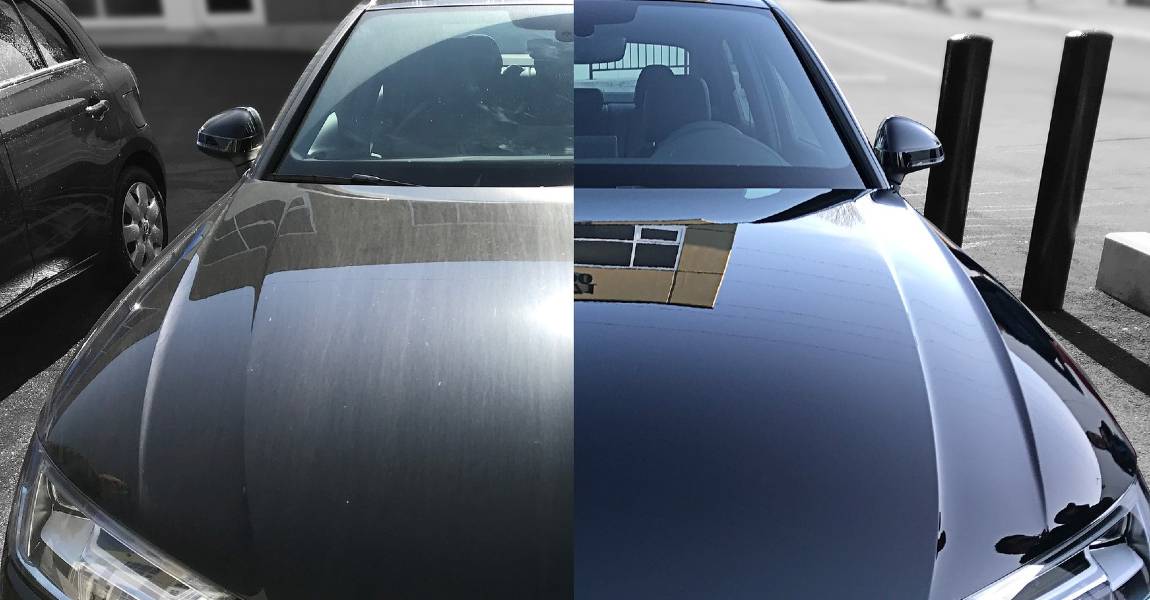Why more drivers are switching to Ceramic Coating Newark this year
Wiki Article
Exploring the Science Behind Car Ceramic Coating and Its Safety Residences
The scientific research of car ceramic coating presents an interesting study in advanced automobile defense. Made up mainly of silicon dioxide and polymers, these finishings create a durable bond with lorry paint. This interaction boosts toughness versus environmental dangers while offering hydrophobic benefits. Nonetheless, the complexities of exactly how these finishings work and their long-term advantages continue to be less comprehended. Unboxing these information discloses why ceramic layers are becoming a recommended choice for vehicle treatmentWhat Is Ceramic Coating?
Ceramic coating is a fluid polymer that chemically bonds to the surface area of a lorry's paint. This sophisticated protective layer enhances toughness and supplies premium resistance to environmental variables. Unlike conventional wax or sealants, which give momentary security, ceramic finishings develop a lasting shield that can stand up to rough problems such as UV rays, acidic pollutants, and extreme weather. When used correctly, the coating forms a hydrophobic surface, creating water to bead and slide off, which assists in keeping the automobile's sanitation. In addition, it supplies boosted gloss and depth to the paint, making the lorry show up even more refined and vivid. The application procedure generally includes thorough surface area prep work, consisting of cleansing and polishing, to guarantee peak bonding. Consequently, ceramic coverings are ending up being increasingly preferred among car enthusiasts and those looking for to shield their investments, assuring to keep the vehicle's visual charm while decreasing the frequency of maintenance.The Composition of Ceramic Coatings
The complex formulation of ceramic coatings largely includes silicon dioxide (SiO2), which is derived from natural sources like quartz and sand. This vital component offers the foundation for the coating's resilience and protective top qualities. In enhancement to SiO2, ceramic finishings often consist of different polymers and ingredients that boost attachment, flexibility, and resistance to ecological aspects. These substances function synergistically to create a robust barrier versus impurities such as dirt, chemicals, and UV rays.Furthermore, some formulations incorporate titanium dioxide (TiO2) or other nanomaterials, which can increase the coating's hydrophobic buildings, leading to improved water repellency. The specific make-up can differ significantly amongst manufacturers, affecting performance and long life. Ultimately, the mix of these components finishes in a safety layer that not only boosts the visual charm of lorries yet additionally serves to prolong their lifespan by securing the surface area from prospective damages.How Ceramic Coatings Job
Recognizing how ceramic layers function involves discovering their chemical make-up, which adds to their safety top qualities. The application process is important for attaining perfect results, while durability and toughness factors determine the coating's performance in time. With each other, these aspects highlight the advantages and efficiency of ceramic finishes for vehicle protection.Chemical Make-up Explained
While many car proprietors seek lasting defense for their lorries, the chemical make-up of ceramic coverings plays an important function in their performance. These coverings primarily contain silicon dioxide (SiO2), which is originated from all-natural minerals. This compound forms a strong bond with the lorry's paint, creating a durable, protective layer. In addition, several ceramic layers contain titanium dioxide (TiO2), improving their hydrophobic residential properties and resistance to UV rays. The visibility of polysiloxanes can further boost adaptability and durability. With each other, these aspects add to the coating's ability to fend off water, dust, and pollutants, while additionally offering a high-gloss surface. Recognizing this chemical structure assists car proprietors appreciate the robust protection supplied by ceramic layers.Application Process Introduction
Using ceramic finishes includes a meticulous procedure that assures suitable bonding and protection for the vehicle's surface area. Initially, detailed cleaning and purification of the car's outside are performed to eliminate dust, gunk, and previous waxes. This action validates that the surface is without contaminations that might impede adhesion. Following this, the paint is often polished to enhance quality and eliminate any kind of blemishes. Once prepared, the ceramic coating is used in little sections making use of an applicator pad, enabling uniform coverage. The coating is then delegated cure, creating a solid chemical bond with the surface. Proper treating times and conditions are vital, as they confirm the coating attains its optimum efficiency and protective high qualities.Long Life and Longevity Factors
Ceramic coatings are made to supply lasting defense via their advanced chemical structure, which produces a robust barrier against environmental pollutants. The sturdiness of these layers is affected by factors such as the density of the application, the quality of the product, and the problems under which the lorry is subjected. High-grade ceramic layers can last several years, resisting scrapes, UV rays, and chemical spots. Correct maintenance, including routine cleaning and routine reapplication, can further improve longevity. Furthermore, ecological elements like environment and direct exposure to toxins can affect the life expectancy of the coating. In general, when applied and kept properly, ceramic coatings provide phenomenal longevity, making them a preferred option for car enthusiasts seeking to maintain their lorry's look.Hydrophobic Qualities and Water Repellency
Hydrophobic properties are a trademark of top quality car ceramic finishes, considerably enhancing the vehicle's surface performance. These finishings create a molecular bond with the car's paint, causing a surface that fends off water properly. When water enters call with a ceramic-coated surface area, it beads up and rolls off, lessening the amount of liquid that continues to be on the paint. This habits not just adds to a cosmetically pleasing appearance yet likewise reduces the buildup of contaminants such as dirt, grime, and road salts.The improved water repellency causes less complicated cleaning and upkeep, as less initiative is called for to remove unwanted materials. In addition, the hydrophobic nature of ceramic coverings helps in stopping water areas, which can mar the finish of uncoated surfaces. Overall, the incorporation of hydrophobic buildings in ceramic coatings plays a crucial role in preserving the vehicle's pristine look while simplifying upkeep.Security Against Scratches and UV Damage
Car ceramic layers offer my explanation substantial protection against scratches and UV damage. The scrape resistance device produces a sturdy layer that takes in impacts, while the UV shielding advantages assist preserve the lorry's paint integrity over time. Together, these features add to a longer-lasting and visually enticing finish.Scratch Resistance Device
Using innovative modern technology, ceramic finishes supply a durable guard versus scratches and UV damage, boosting the long life and appearance of car surface areas. The scrape resistance device of these coatings is attributed to their special molecular structure, which forms a resilient bond with the automobile's paint. This bond creates a hard, protective layer that can absorb influences and withstand abrasions. In addition, the smooth surface of the coating minimizes rubbing, making it hard for contaminants to stick and cause scratches. The chemical structure of ceramic coverings often consists of nanoparticles that strengthen the protective layer, additional enhancing its durability. Consequently, lorries treated with ceramic coatings show significantly boosted scratch resistance contrasted to standard wax or sealants, guaranteeing a pristine surface over time.UV Shielding Perks
The safety top qualities of ceramic coverings expand past scrape resistance to consist of substantial UV shielding benefits. These finishes create a robust barrier that mirrors damaging ultraviolet rays, securing the car's paint and underlying products. Extended exposure to UV radiation can lead to fading, oxidation, and deterioration of the paint coating. By including ceramic coverings, vehicle owners can efficiently reduce these risks, protecting the aesthetic allure and stability of their cars and trucks. Additionally, the UV blocking buildings add to boosted longevity, lowering the frequency of painting and upkeep. Eventually, the integration of ceramic finishes provides a complete service for safeguarding lorries from the damaging results of sun exposure, guaranteeing a sustained, vivid look with time.The Long life and Upkeep of Ceramic Coatings

Regularly Asked Inquiries
Can Ceramic Coating Be Applied to Any Kind Of Lorry?
Ceramic coating can be put on different kinds of automobiles, including cars and trucks, vehicles, and motorbikes. However, surface area preparation and compatibility with particular materials are vital for suitable attachment and efficiency of the coating.How Much Does Ceramic Coating Generally Price?
Ceramic coating usually costs in between $500 and $2,000, depending on elements such as lorry size, coating high quality, and specialist application. The financial investment can give resilient defense and boost the lorry's appearance over time.
Is Specialist Application Required for Finest Results?
The necessity of professional application typically depends on wanted outcomes. Specialists generally ensure correct surface preparation and application methods, leading to optimal bonding and durability of the coating, which may be challenging for inexperienced individuals to accomplish.Can Ceramic Coatings Be Eliminated or Fixed?
Ceramic finishes can be eliminated or repaired, though the process might need particular solvents or strategies - Ceramic Coating Newark. Correct removal is important to stay clear of damages to the underlying surface, highlighting the relevance of professional help for ideal resultsExactly How Does Ceramic Coating Compare to Standard Wax?
The comparison between ceramic coating and conventional wax exposes that ceramic layers supply superior durability, boosted defense versus ecological impurities, and longer-lasting luster, while wax needs extra regular application and offers less total resistance to damages.Report this wiki page